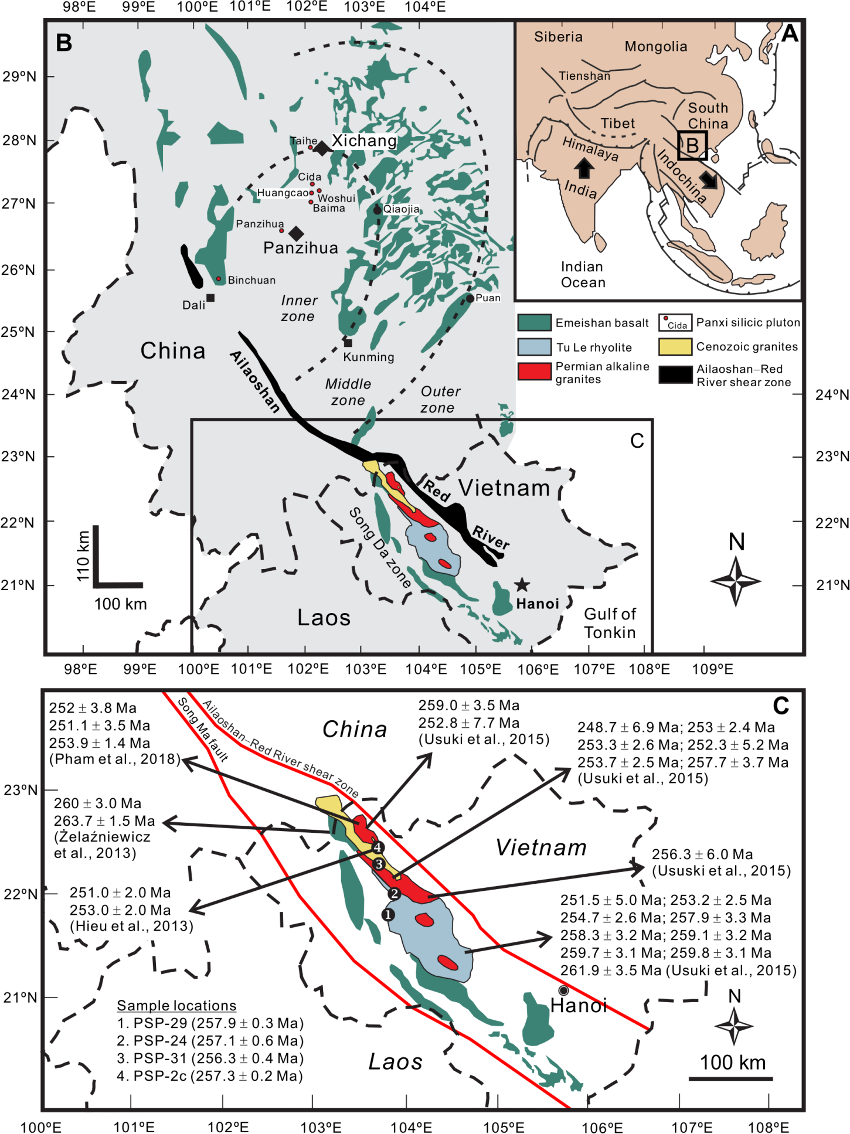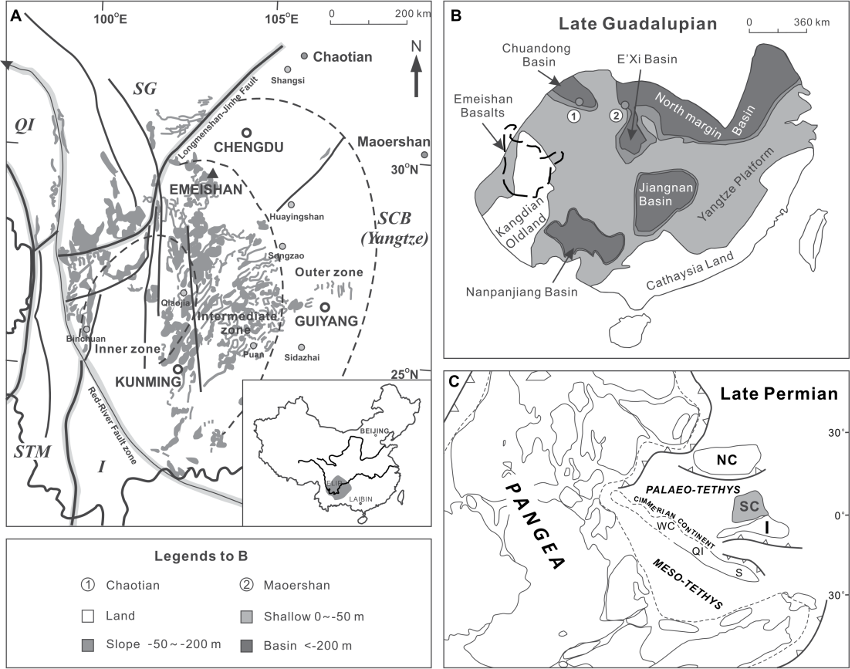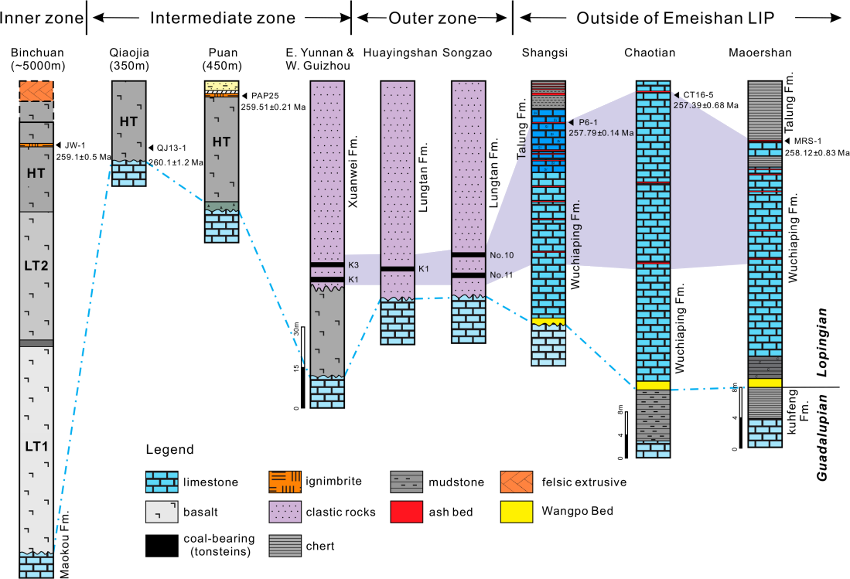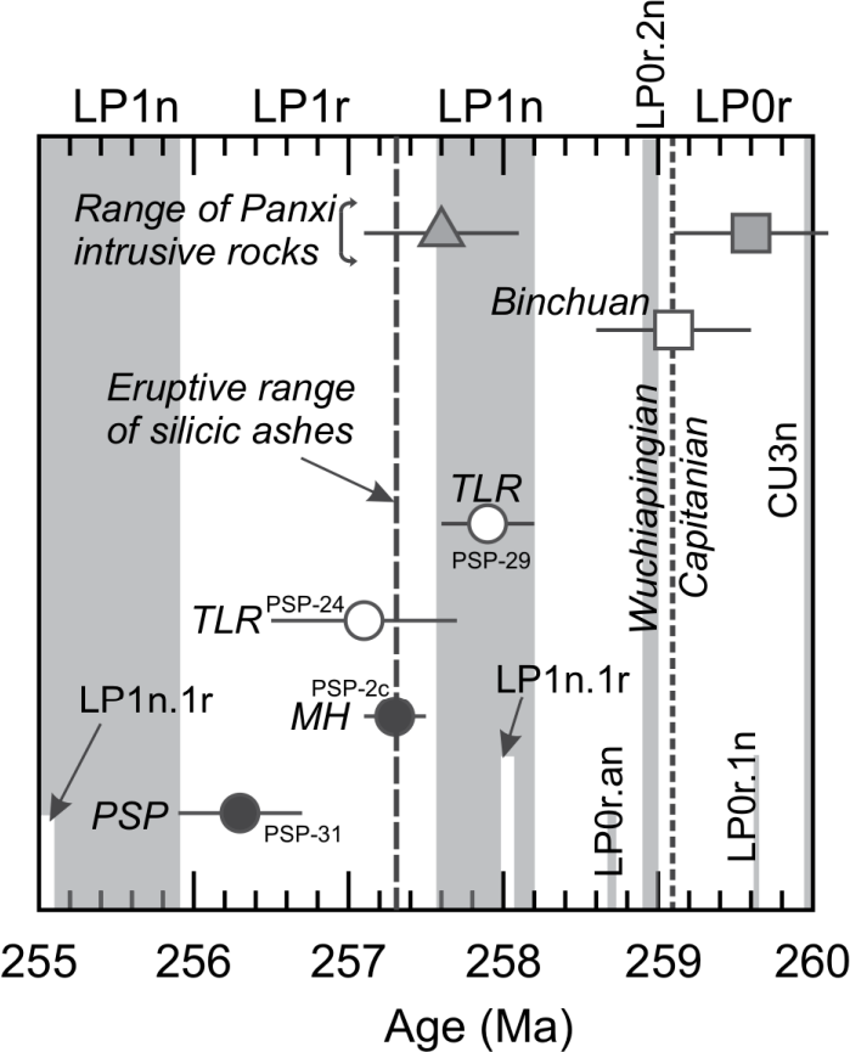February 2020 LIP of the Month
End of magmatism related to the Emeishan Large Igneous Province
Steve Denyszyn
University of Western Australia, School of Earth Sciences, Perth, Australia
Figures and text modified after Zhong et al (2020) and Shellnutt et al. (2020).
The Emeishan Large Igneous Province (ELIP) in southwest China and northern Vietnam preserves one of the major continental flood basalt eruptions in the Permian (Chung and Jahn, 1995; Xu et al., 2001; Shellnutt, 2014). The associated volcanic products have been extensively studied and are inferred to be connected with the end-Guadalupian biotic crisis (Hallam and Wignall, 1999; Zhou et al., 2002; He et al., 2007; Wignall et al., 2009; Zhong et al., 2014). The ELIP is one of the most comprehensively studied large igneous provinces, but there are several issues yet to be resolved, particularly the duration of magmatism (Shellnutt, 2014). The onset of volcanism is estimated by conodont stratigraphy of interflow limestones correlative to the underlying Maokou Formation: the appearance of Jinogondolella altudaensis and J. granti constrains the eruption of the initial flows to 263–262 Ma (He et al., 2007; Sun et al., 2010). Paleomagnetic studies indicate that a single geomagnetic reversal occurred between the eruption of the lower basalt flows and the younger upper flows, suggesting that eruption occurred within 3 Ma or less (Zheng et al., 2010; Xu et al., 2018). However, high-precision radioisotopic geochronology indicates that magmatism and possibly volcanism extended beyond 3 Ma (Shen et al., 2011; Shellnutt et al., 2012). Marine Permian stratigraphic records are well-exposed and preserved in south China, which include numerous volcanic ash beds that can be used as time markers constraining deposition rates and the timing of biotic processes. They also enable the rate of volcanic emissions to be assessed, a critical element in determining the influence of magmatism on climatic change and mass extinction. Understanding of the end Permian mass extinction has been greatly enhanced in the past three decades, through use of high-precision geochronology and high-resolution biostratigraphy (Shen et al. 2019a,b; Burgess et al. 2015, and references in these). In contrast, temporal constraints on the end-Guadalupian biotic crisis and its potential primary cause, Emeishan LIP magmatism, are relatively scarce (Zhou et al., 2002; He et al., 2007, 2010; Wignall et al., 2009; Sun et al., 2010; Shellnutt et al., 2012), and firm constraints on the overall duration of Emeishan LIP magmatism and precise correlation with biodiversity changes in the sedimentary records around the Guadalupian–Lopingian boundary (GLB) are greatly needed if we are to test the hypothesized causal connection between volcanism and extinction.
Two recent studies (Zhong et al. 2020; Shellnutt et al. 2020, of which this article is largely a précis) have made significant contributions to resolving the question of the timing of termination of ELIP magmatism. The former provides new constraints on the latest volcanism as recorded in ash deposits to the northwest of the main ELIP centre; the latter provides ages of intrusive and extrusive felsic rocks in Vietnam, formerly proximal to the bulk of ELIP magmatism but later offset along a major strike-slip fault.
Previous estimates for the age of the latest volcanism were interpreted from two different silicic ashes from the sequences at Binchuan (Yunnan, China) and Puan (Guizhou, China). Chemical abrasion–isotope dilution–thermal ionization mass spectrometry (CA-ID-TIMS) yielded zircon 206Pb/238U ages of 259.1 ± 0.5 Ma for the Binchuan ignimbrite and 259.69 ± 0.72 Ma for the Puan claystone (Zhong et al., 2014; Yang et al., 2018). However, mafic dykes and silicic plutons in the Panzhihua area are generally younger, with CA-ID-TIMS zircon 206Pb/238U ages from 259.6 ± 0.5 Ma to 257.6 ± 0.5 Ma (Shellnutt et al., 2012), and based on a review of U-Pb (zircon, monazite) geochronology studies from volcanic ashes across the ELIP (Huang et al. 2018) the age of Shen et al. (2011) of 257.79 ± 0.14 Ma for an ash bed in the Shangsi section, ∼300 km northeast of the ELIP, has been proposed as recording the latest ELIP volcanism. This supports the notion that Emeishan volcanism continued for millions of years after the deposition of the Binchuan and Puan ashes.
Shellnutt et al. (2020) report new ages for critical outcrops in northern Vietnam. The Tu Le Basin and Phan Si Pan uplift region were displaced from southwestern China to the southeast along the Ailaoshan–Red River shear zone during the late Paleogene (Chung et al., 1997). The Tu Le–Phan Si Pan region comprises both volcanic and intrusive rocks, including the largest (≥104 km3) contiguous silicic volcanic unit of the ELIP (Anh et al., 2011; Usuki et al., 2015). Based on structural relationships, the Tu Le rhyolite is the youngest volcanic unit in the region and may be related to neighbouring silicic plutons (Tran et al., 2015). In situ zircon laser ablation–inductively coupled plasma–mass spectrometry (LA-ICP-MS) U-Pb dating of the silicic rocks in the area confirms a late Permian age, but the results span ca. 10 Ma and lack analytical precision to provide robust limits on the duration of magmatism (Pham et al., 2018). Shellnutt et al. (2020) determined zircon CA-ID-TIMS 206Pb/238U ages of the Tu Le rhyolite (257.1 ± 0.6 Ma to 257.9 ± 0.3 Ma) and the Muong Hum (257.3 ± 0.2 Ma) and Phan Si Pan (256.3 ± 0.4 Ma) plutons. The new data set provides unequivocal ELIP-compatible ages of the Tu Le–Phan Si Pan rocks and extends the terminal eruption age, as these represent the youngest known ages for ELIP-associated magmatic rocks.
Zhong et al. (2020) present new zircon CA-ID-TIMS 206Pb/238U ages for ash layers from the Chaotian and Maoershan Permian sections to the northeast of the main ELIP magmatism. These ash beds are altered, but contain single populations of zircons that yield coherent, concordant clusters of U-Pb data. Based on biostratigraphic and geochemical results also presented in Zhong et al. (2020), these layers have Hf isotopic values consistent with assignment to ELIP magmatism, and definitely postdate the end-Guadalupian extinction. The 206Pb/238U weighted-mean ages of 258.82 ± 0.61 Ma to 257.39 ± 0.68 Ma are in good agreement with the youngest intrusive ages of Shellnutt et al. (2012, 2020) as well as that of the Tu Le rhyolite of Vietnam (above).
Taken together, after early geochronological data indicated a prolonged (ca. 20 Ma) duration of ELIP magmatism, and initial high-precision U-Pb analyses reduced that duration to ca. 3 Ma (see Shellnutt et al. 2012 and references therein), further geochronological exploration of later, silicic components of ELIP magmatism has expanded that range somewhat, to ca. 6 Ma. This provides essential constraints on mass-balance calculations of rates of ELIP-related emissions and magmatic emplacement.

Figure 1: Map of the Emeishan large igneous province (ELIP), Ailaoshan–Red River shear zone, and Tu Le–Phan Si Pan region (southwestern China and northern Vietnam) as relevant in Shellnutt et al. (2020). (A) Inset map of major suture zones of eastern Asia. (B) Simplified map of the ELIP showing distribution of crustal zonation and position of main flood basalt relative to the displaced Tu Le–Phan Si Pan region. (C) Simplified geological map of the Tu Le–Phan Si Pan region with a summary of in situ zircon geochronology and sample locations for that study.

Figure 2: Location maps as relevant to Zhong et al. (2020). (A) Schematic map showing the Chaotian and Maoershan sections studied and the distribution of the Emeishan Large Igneous Province, modified from He et al. (2007). The dashed lines separate the inner, intermediate, and outer zones. SCB = south China block; SG = Songpan-Ganze; QI = Qiangtang; STM = San–Thai–Malay; I = Indochina. (B) Reconstructed paleogeographic map showing the Late Guadalupian isolated basins of the Yangtze Platform in south China. (C) Global plate reconstruction and position of south China block (SC) in the Late Permian, after Metcalfe (1996). NC = north China; WC = western Cimmerian continent; S = Sibumasu; I = Indochina; QI = Qiangtang.

Figure 3: From Zhong et al. (2020): Stratigraphic correlation in the Emeishan LIP and sections studied. Locations of the section are shown in Figure 2A. Data are from Zhong et al. (2014); Li et al. (2018); Yang et al. (2018); Zhao and Graham (2016); Shen et al. (2011); and this study.

Figure 4: From Shellnutt et al. (2020): Summary of eruptive and magmatic durations of Emeishan large igneous province (southwestern China and northern Vietnam). The Binchuan ignimbrite (white square; Yunnan, China) was deposited (206Pb/238U age = 259.1 ± 0.5 Ma) at the Wuchiapingian-Capitanian boundary (Zhong et al., 2014). The eruptive range (260–257.3 Ma) of silicic ashes is based on Huang et al. (2018). CA-ID-TIMS 206Pb/238U ages (259.6 ± 0.5 Ma to 257.6 ± 0.5 Ma) of Panxi mafic (gray triangle is mafic dyke) and silicic intrusive (grey square is Woshui syenite) rocks are from Shellnutt et al. (2012). White circles are the Tu Le volcanic rocks of Shellnutt et al. (2020) (PSP-29, PSP-24), and black circles are the Muong Hum (PSP-2c) and Phan Si Pan (PSP-31) granitic rocks of that study. Permian geomagnetic polarity time scale magnetochron intervals (labeled grey and white bands) of Hounslow and Balabanov (2016) is added. TLR = Tu Le rhyolite; MH = Muong Hum gran-ite; PSP = Phan Si Pan granite
References
Anh, T.V., Pang, K.-N., Chung, S.-L., Lin, H.-M., Hoa, T.T., Anh, T.T., and Yang, H.-J., 2011, The Song Da magmatic suite revisited: A petrologic, geochemical and Sr-Nd isotopic study on picrites, flood basalts and silicic volcanic rocks: Journal of Asian Earth Sciences, v. 42, p. 1341–1355
Burgess, S.D., Bowring, S.A., and Shen, S.Z., 2015, High-precision geochronology confirms voluminous magmatism before, during, and after Earth’s most severe extinction: Science Advances, v. 1, p. e1500470
Chung, S.-L., Lee, T.-Y., Lo, C.-H., Wang, P.-L., Chen, C.-Y., Yem, N.T., Hoa, T.T., and Wu, G., 1997, Intraplate extension prior to continental extrusion along the Ailao Shan–Red River shear zone: Geology, v. 25, p. 311–314
Chung, S.L., and Jahn, B.M., 1995, Plume-lithosphere interaction in generation of the Emeishan flood basalts at the Permian–Triassic boundary: Geology, v. 23, p. 889–892
Hallam, A., and Wignall, P.B., 1999, Mass extinctions and sea-level changes: Earth-Science Reviews, v. 48, p. 217–250
He, B., Xu, Y.G., Zhong, Y.T., and Guan, J.P., 2010, The Guadalupian–Lopingian boundary mudstones at Chaotian (SW China) are clastic rocks rather than acidic tuffs: Implication for a temporal coincidence between the end-Guadalupian mass extinction and the Emeishan volcanism: Lithos, v. 119, p. 10–19
He, B., Xu, Y.G., Huang, X.L., Luo, Z.Y., Shi, Y.R., Yang, Q.J., and Yu, S.Y., 2007, Age and duration of the Emeishan flood volcanism, SW China: Geochemistry and SHRIMP zircon U-Pb dating of silicic ignimbrites, post-volcanic Xuanwei Formation and clay tuff at the Chaotian section: Earth and Planetary Science Letters, v. 255, p. 306–323
Huang, H., Cawood, P.A., Hou, M.C., Ni, S.J., Yang, J.H., Du, Y.S., and Wen, H.G., 2018, Provenance of Late Permian volcanic ash beds in South China: Implications for the age of Emeishan volcanism and its linkage to climate cooling: Lithos, v. 314–315, p. 293–306
Pham, M., Pham, T.H., and Nguyen, K.H., 2018, Geochemical and geochronological studies of the Muong Hum alkaline granitic pluton from the Phan Si Pan zone, northwest Vietnam: Implications for petrogenesis and tectonic setting: Island Arc, v. 27, e12250
Shellnutt, J.G., 2014, The Emeishan large igneous province: A synthesis: Geoscience Frontiers, v. 5, p. 369–394
Shellnutt J. G., Pham T. T., Denyszyn S. W., Yeh M.-W., Tran T.-A. (2020) Magmatic duration of the Emeishan large igneous province: Insight from northern Vietnam. In press with Geology.
Shellnutt, J.G., Denyszyn, S.W., and Mundil, R., 2012, Precise age determination of mafic and felsic intrusive rocks from the Permian Emeishan large igneous province (SW China): Gondwana Research, v. 22, p. 118–126
Shen, S.Z., Ramezani, J., Chen, J., Cao, C.Q., Erwin, D.H., Zhang, H., Xiang, L., Schoepfer, S.D., Henderson, C.M., Zheng, Q.F., Bowring, S.A., Wang, Y., Li, X.H., Wang, X.D., Yuan, D.X., Zhang, Y.C., Mu, L., Wang, J., and Wu, Y.S., 2019a, A sudden end-Permian mass extinction in South China: Geological Society of America Bulletin, v. 131, p. 205–223
Shen, S.Z., Zhang, H., Zhang, Y.C., Yuan, D.X., Chen, B., He, W.H., Mu, L., Lin, W., Wang, W.Q., Chen, J., Wu, Q., Cao, C.Q., Wang, Y., and Wang, X.D., 2019b, Permian integrative stratigraphy and timescale of China: Science China: Earth Sciences, v. 62, p. 154–188
Shen, S.Z., Crowley, J.L., Wang, Y., Bowring, S.A., Erwin, D.H., Sadler, P.M., Cao, C.Q., Rothman, D.H., Henderson, C.M., Ramezani, J., Zhang, H., Shen, Y.N., Wang, X.D., Wang, W., Mu, L., Li, W.Z., Tang, Y.G., Liu, X.L., Liu, L.J., Zeng, Y., Jiang, Y.F., and Jin, Y.G., 2011, Calibrating the end-Permian mass extinction: Science, v. 334, p. 1367–1372
Sun, Y.D., Lai, X.L., Wignall, P.B., Widdowson, M., Ali, J.R., Jiang, H.S., Wang, W., Yan, C.B., Bond, D.P.G., and Vedrine, S., 2010, Dating the onset and nature of the Middle Permian Emeishan large igneous province eruptions in SW China using conodont biostratigraphy and its bearing on mantle plume uplift models: Lithos, v. 119, p. 20–33
Tran, H.T., Lan, C.-Y., Usuki, T., Shellnutt, J.G., Pham, T.D., Tran, T.A., Pham, N.C., Ngo, T.P., Izokh, A.E., and Borisenko, A.S., 2015, Petrogenesis of Late Permian silicic rocks of Tu Le basin and Phan Si Pan uplift (NW Vietnam) and their association with the Emeishan large igneous province: Journal of Asian Earth Sciences, v. 109, p. 1–19
Usuki, T., Lan, C.-Y., Tran, T.H., Pham, T.D., Wang, K.-L., Shellnutt, J.G., and Chung, S.-L., 2015, Zircon U-Pb ages and Hf isotopic compositions of alkaline silicic magmatic rocks in the Phan Si Pan–Tu Le region, northern Vietnam: Identification of a displaced western extension of the Emeishan large igneous province: Journal of Asian Earth Sciences, v. 97, p. 102–124
Wignall, P.B., Sun, Y.D., Bond, D.P.G., Izon, G., Newton, R.J., Vedrine, S., Widdowson, M., Ali, J.R., Lai, X.L., Jiang, H.S., Cope, H., and Bottrell, S.H., 2009, Volcanism, mass extinction, and carbon isotope fluctuations in the Middle Permian of China: Science, v. 324, p. 1179–1182
Xu, Y., Yang, Z., Tong, Y.-B., and Jing, X., 2018, Paleomagnetic secular variation constraints on the rapid eruption of the Emeishan continental flood basalts in southwestern China and northern Vietnam: Journal of Geophysical Research: Solid Earth, v. 123, p. 2597–2617
Xu, Y.G., Chung, S.L., Jahn, B.M., and Wu, G.Y., 2001, Petrologic and geochemical constraints on the petrogenesis of Permian–Triassic Emeishan flood basalts in southwestern China: Lithos, v. 58, p. 145–168
Yang, J.H., Cawood, P.A., Du, Y.S., Condon, D.J., Yan, J.X., Liu, J.Z., Huang, Y., and Yuan, D.X., 2018, Early Wuchiapingian cooling linked to Emeishan basaltic weathering?: Earth and Planetary Science Letters, v. 492, p. 102–111
Zheng, L., Yang, Z., Tong, Y., and Yuan, W., 2010, Magnetostratigraphic constraints on two-stage eruptions of the Emeishan continental flood basalts: Geochemistry Geophysics Geosystems, v. 11, Q12014
Zhong Y., Mundil R., Chen J., Yuan D., Denyszyn S. W., Jost A., Payne J., He B., Shen S., Xu Y. (2020) Geochemical, biostratigraphic, and high-resolution geochronological constraints on the waning stage of the Emeishan Large Igneous Province. In press with GSA Bulletin.
Zhong, Y.T., He, B., Mundil, R., and Xu, Y.G., 2014, CA–TIMS zircon U-Pb dating of felsic ignimbrite from the Binchuan section: Implications for the termination age of Emeishan large igneous province: Lithos, v. 204, p. 14–19
Zhou, M.F., Malpas, J., Song, X.Y., Robinson, P.T., Sun, M., Kennedy, A.K., Lesher, C.M., and Keays, R.R., 2002, A temporal link between the Emeishan large igneous province (SW China) and the end-Guadalupian mass extinction: Earth and Planetary Science Letters, v. 196, p. 113–122
